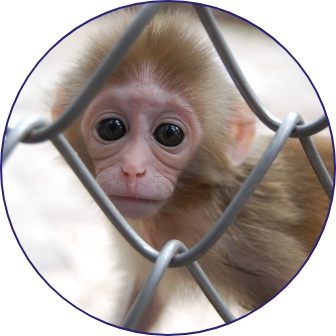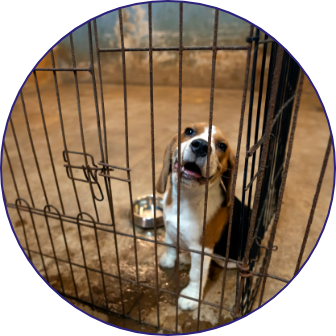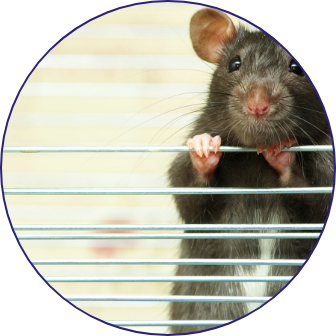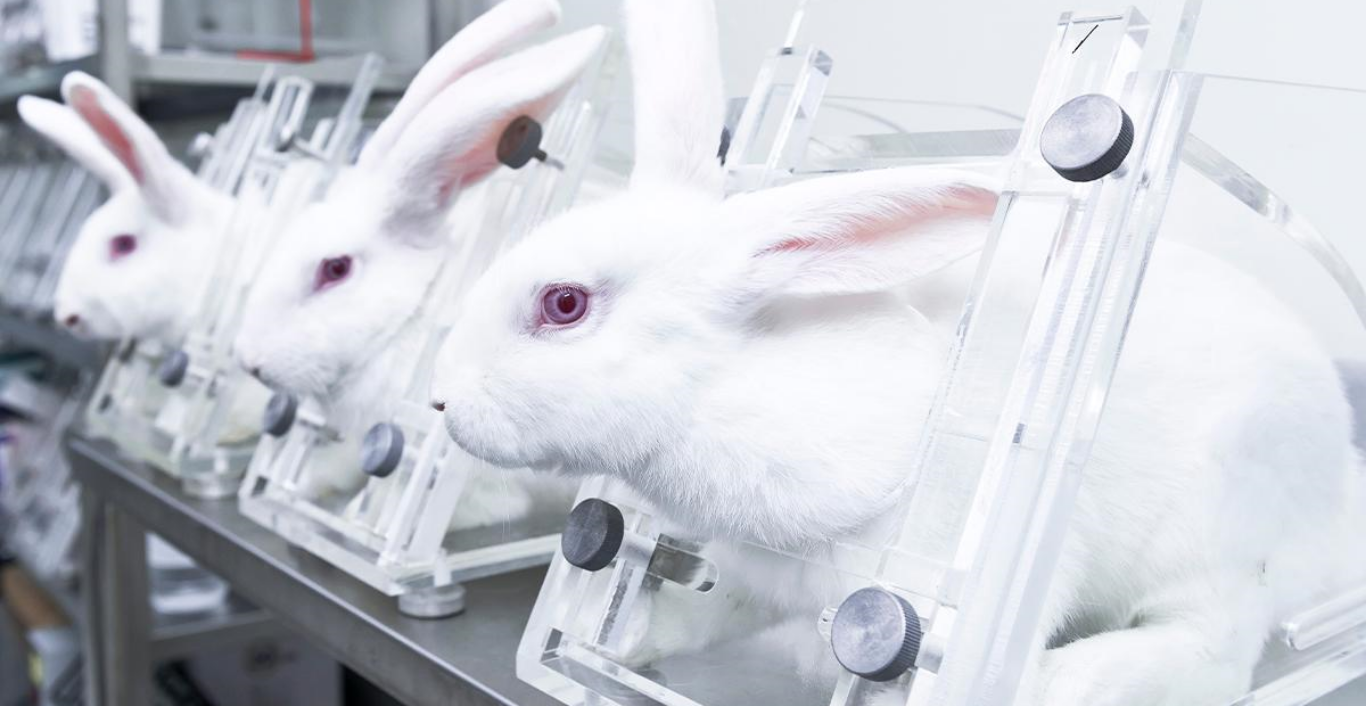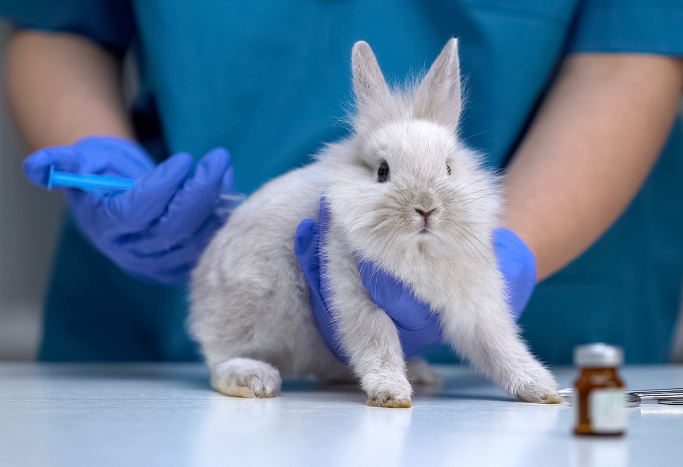In Defense of Animals is fighting for a complete ban on animal testing.
Animal testing, originally called “vivisection,” was invented and popularized in the Victorian era. It was fashionable science at a time when many scientists did not recognize that animals can feel complex emotions. Sadly, animals endure torturous tests and suffer in secrets in laboratories to this day. This is despite the many alternatives to animal testing and countless reasons to ban animal testing.
Video and photographic evidence consistently exposes our worst fears about what takes place behind closed doors. Terrified monkeys have their skulls sliced open while locked into restraints. Dogs and cats are strapped into harnesses while poison is pumped through their veins. While. Smaller animals like rats and mice, uncounted, yet numbering in the millions, are forced to endure overwhelming pain.
- Reasons To Ban Animal Testing
- How We Help Stop Vivisection
- Take Action against Vivisection
- Latest Vivisection News
Reasons To Ban Animal Testing
High profile scientists have exposed the flaws of animal experiments. Dr. Richard Klausner, former director of the US National Cancer Institute has said:
The history of cancer research has been the history of curing cancer in the mouse. We have cured mice of cancer for decades and it simply didn’t work in human beings.
Animal experiments are fatally flawed because each species reacts differently from one to another. It goes without saying that cats, dogs, and other animals are built differently than us. We don’t share our medications with our animal companions because they could harm or even kill them.
Similarly, drugs that seemed promising in animal tests have seriously harmed humans. Prescription drugs continue to be a leading cause of human death despite passing animal tests.
Animal Testing is Ineffective
The National Institutes of Health indicates that approximately 95% of new drugs fail during research and development. According to the Pharmaceutical Research and Manufacturers of America, only 12% of investigative medicines entering human clinical trials are ultimately approved, despite showing positive results in animal trials beforehand.
Our bodies are different from other animals. This is why animal experiments overwhelmingly fail to produce the effective treatments we seek.
Science is heading toward a more humane future. However, it is up to us to lobby for modern science to be implemented. Whether you are concerned about animal suffering, your own health, or both, we must embrace human-focused science and stop wasting money and scientific talent on outdated and barbaric animal experiments.
To make these tests even more tragic, the animals used are mercilessly killed once testing concludes, often by suffocation, decapitation, or neck-breaking.
Animal testing is inhumane
Animals in laboratories are trapped, forced to test new medications and vaccines. Mice, rats, cats, dogs, guinea pigs, primates, and other animals are exposed to test substances to determine lethal doses and side effects.
They may undergo agonizing, often life-threatening procedures without painkillers. They may be starved, drowned, intentionally addicted to drugs, burned, and infected with diseases. Some animals are bred with genetic modifications to express specific diseases or traits, which may result in tumors, psychological disorders, blindness, and more.
When the torture is complete, the animals are often killed and discarded.
What is cosmetics testing?
Cosmetics animal testing includes outdated, scientifically unreliable methods of determining the safety of a product. For these tests, innocent animals, including rabbits, mice, rats, hamsters, and guinea pigs, are confined, restrained, and exposed to finished cosmetic products or ingredients included in a product’s formula.
Testing on animals for cosmetics may include:
- dripping chemicals into animals’ eyes or rubbing chemicals onto their shaved skin to observe the results, which may include burns, lesions, bleeding, ulcers, and loss of vision.
- forcing animals to inhale test substances.
- force-feeding animals to ingest test substances over prolonged periods of time to observe the effects, which may range from general illness to cancer, seizures, birth defects, death, or anything in between.
- "lethal dose" tests in which animals are forced to consume large amounts of a test substance to determine the dose that kills them.
How We Help Stop Vivisection
In Defense of Animals began in 1983 when our founder, veterinarian Dr. Katz was contacted by an animal-advocacy organization seeking his help about reportedly abusive and scandalous conditions for animals on the UC Berkeley campus animal laboratories.
What Dr. Katz discovered there was worse than he could have ever imagined. It was a veterinarian’s nightmare. Animals living in grossly overcrowded and filthy facilities were suffering and dying by the hundreds from heatstroke, complications following surgery, gangrene, bacterial meningoencephalitis and viral epidemics. Campus veterinarians were unable to perform their jobs, and in some instances, were even locked out of laboratories where animals in need were sick and dying.
Dr. Katz brought together a group of concerned citizens to bring legal action against the USDA and the university. The group filed a lawsuit against the USDA which forced the agency to issue a cease and desist order against UC Berkeley, and was ultimately fined $12,000 for violating the Animal Welfare Act.
After that, In Defense of Animals went on to investigate and successfully shut down the Coulston Foundation. This vile horror-house was the world’s largest chimpanzee lab at the time. All of the survivors were sent to sanctuaries.
We have been on the cutting edge of legal strategy for animals and the environment. We realize that investment in, and construction of, new animal research facilities would only increase the horrors of vivisection. We have investigated labs, shut them down, got animals retired to sanctuaries and prevented others from being built in the first place.
In addition to this, we have:
- Advocated for the Humane Cosmetics Act, which would eliminate cruel and ineffective testing and would also ban the sale of animal-tested cosmetics throughout the United States.
- Produced Cruelty-Free Shopping Guides, making it easier than ever for consumers to make ethical choices.
- Campaigned against the mass killing of animals in university labs.
- Supported and promoted World Week for Animals In Laboratories #United4AnimalsinLabs
What You Can Do
- Help us stop animal testing by signing up for an In Defense of Animals membership
- Always shop cruelty-free, where possible
- Sign one of our active alerts to stop vivisection
- Read our latest Vivisection news to stay up-to-date
1 million
animals are killed every year in labs in the USA. This number excludes mice, rats, birds, reptiles and amphibians.
Rats and mice are used in the majority of animal experiments in the USA, however the true numbers are shrouded in secrecy.
It is estimated that between 11 and 100 million rats and mice are used every year in animal testing.


